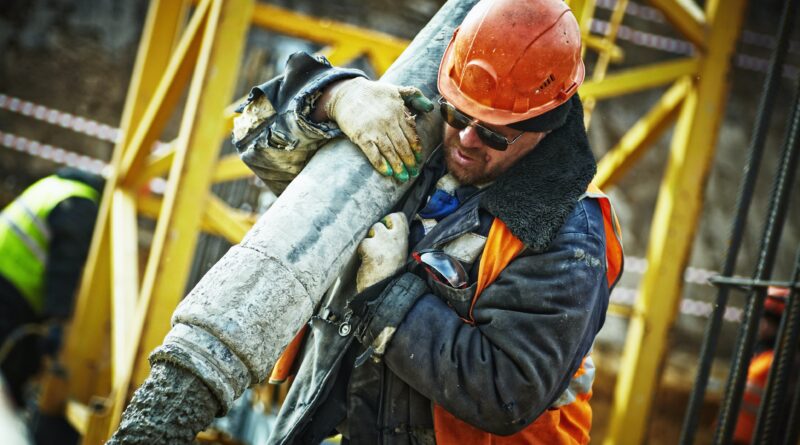The Beauty of Manual Labor
There’s nothing like the mental cleansing that comes from hard, physical labor – the act of creating something from nothing with your hands, or putting your back into it and grunting your way through. In my teens I began to appreciate the tactile satisfaction that results from physical movement and exertion. There’s also nothing quite like surveying what you’ve built after it’s done.
I can relate the purity of movement to athletics, except for one important factor – when it’s your job, you do it every day, month after month, year after year. Building, digging, lifting, moving, assembling, testing, finishing; making something at once beautiful and utilitarian where nothing existed before. Investing your blood and sweat into it. I think there’s a link between mental and physical health you can’t get any other way, and I have a feeling that link is rarely appreciated by anyone who does not have a physically demanding job. How can you?
Then there’s the whole concept of building things or fixing them so they are still useful. Sure, it can be a pain in the ass, but so can any job. It’s the satisfaction of doing we are after, and fixing something is a straightforward way to do it. On top of that, chances are you’re helping someone just by the doing.
I’m interested in maintaining things so they last. That means doing some work with your hands – and I don’t mean by typing code. You know, that old fashioned thing called manual labor. I can remember doing plenty of projects on cars and homes – pulling engines and painting cars, replacing starters and water pumps, rebuilding brakes, tearing out dashboards and fixing electrical gremlins; roofing or digging ditches, gutting houses and re-plumbing or re-wiring them, felling and chopping cord wood, pouring concrete. Whether it’s tearing down, rebuilding or starting anew there’s always satisfaction and accomplishment in it. It’s not conceptual or theoretical. It’s real, tangible. Touch it, hold it, make it move; use tools to manipulate materials and assemble things into something that has a purpose, a function.
We tend to look down our noses at those who do the hard work. I don’t care how you cut it or what you’re doing – working at a desk is easier than working outside in the weather, or in a drafty garage, or crawling and climbing around something. There’s no real recognition, there’s little glory. There’s mostly just you knowing you are contributing in a real functional way that keeps all of us moving forward.
This kind of life tends to simplify things. The idea of trying is good and all, but in this context it doesn’t amount to anything. What matters is doing and either succeeding or failing. Success is always the goal; failing means changing things up and doing it again. Getting it right means we get to move on. When we work with our hands, that’s the only way it happens; step two can’t be accomplished until step one is completed and ready to be built upon.
In that sense, the lives of these people have little grey in them. Yes, there are always circumstances that shape success and make it either less or more likely. But in the end, there is either accomplishment or failure, either a yes or a no, do or do not do; something either works or it doesn’t. The only thing in the middle is action or no action. No action guarantees the status quo. In the mind of a physical doer, no action means failure. It is the act that gives both them and the thing purpose and accomplishment and a sense they are contributing to what is good.
I watched my Dad do everything himself. If he didn’t know how, he would learn from someone who did or figure it out for himself. My brother and I were the gofers, the laborers. We moved a lot of dirt, rock and clay, and did our share of crawling around in unsavory places. We learned the other stuff by watching and doing, working at service stations and hardware stores. When you have no money, you do most things because you don’t have a choice. Some of those things you learn to like doing, but it’s always related to the sense of tactile skill and accomplishment, of making something work again. Most of the time fixers don’t think about the act of the doing, they think about the result. Does the result meet their expectations? In the end, it’s the ability to act that brings the result. The act is what’s important because it makes the utility of the thing possible.
For me, it’s pretty much always been some kind of hands-on life, even when I started as a drafter in aerospace. In those days, you designed stuff by actually drawing it with your hands, using straight edges, triangles and french curves with vellum and pencil or mylar and black ink. All the stuff was real, tools you held in your hands. You used those things to create pictures and instructions to build other things. For me, it was an extension of the tactility of building. All that was lost when computers came along and changed it all. I had loved the craft of drawing as much as the thought process of designing. I had to move on and adapt. For me that meant carving out a place in management and learning a whole new set of rules. I miss the craft of drafting.
It’s my hope we don’t do the same to the fixers and builders of things. There will be so much we miss out on if we eliminate the wonderful feeling of touching and working on things ourselves. At least in part, interacting with materials is what keeps us in touch with what’s real and with Mother Nature, with respecting her and appreciating her power. There’s nothing like a hard day’s work of manual labor to do that.




